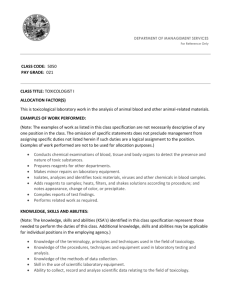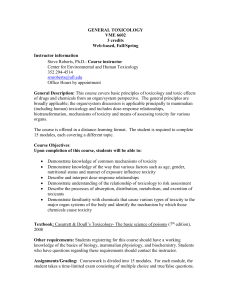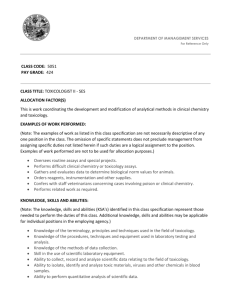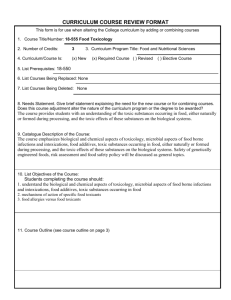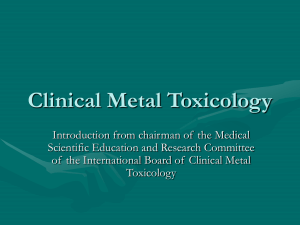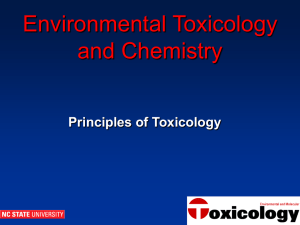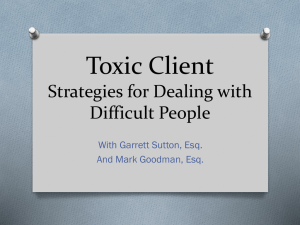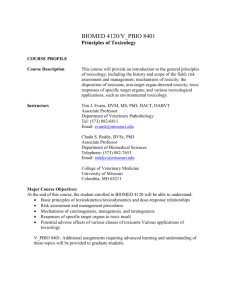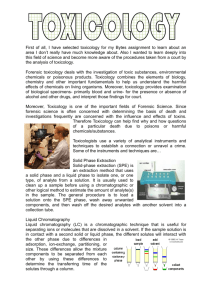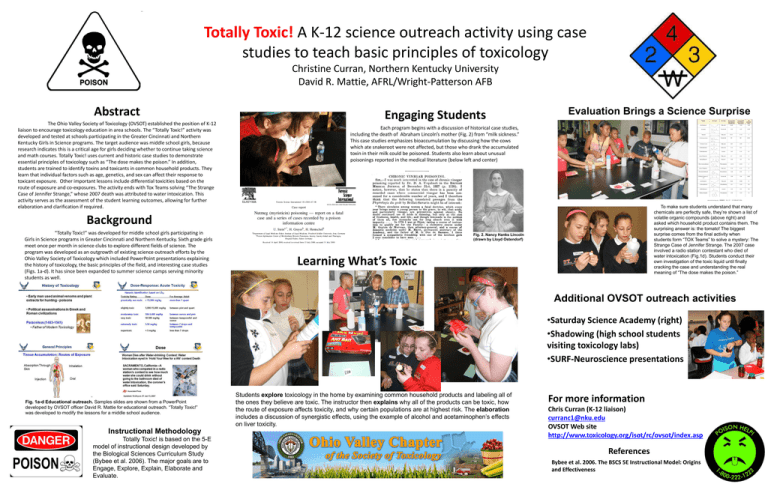
Totally Toxic! A K-12 science outreach activity using case
studies to teach basic principles of toxicology
Christine Curran, Northern Kentucky University
David R. Mattie, AFRL/Wright-Patterson AFB
Abstract
The Ohio Valley Society of Toxicology (OVSOT) established the position of K-12
liaison to encourage toxicology education in area schools. The “Totally Toxic!” activity was
developed and tested at schools participating in the Greater Cincinnati and Northern
Kentucky Girls in Science programs. The target audience was middle school girls, because
research indicates this is a critical age for girls deciding whether to continue taking science
and math courses. Totally Toxic! uses current and historic case studies to demonstrate
essential principles of toxicology such as “The dose makes the poison.” In addition,
students are trained to identify toxins and toxicants in common household products. They
learn that individual factors such as age, genetics, and sex can affect their response to
toxicant exposure. Other important lessons include differential toxicities based on the
route of exposure and co-exposures. The activity ends with Tox Teams solving “The Strange
Case of Jennifer Strange,” whose 2007 death was attributed to water intoxication. This
activity serves as the assessment of the student learning outcomes, allowing for further
elaboration and clarification if required.
Engaging Students
Evaluation Brings a Science Surprise
Each program begins with a discussion of historical case studies,
including the death of Abraham Lincoln’s mother (Fig. 2) from “milk sickness.”
This case studies emphasizes bioaccumulation by discussing how the cows
which ate snakeroot were not affected, but those who drank the accumulated
toxin in their milk could be poisoned. Students also learn about unusual
poisonings reported in the medical literature (below left and center)
To make sure students understand that many
chemicals are perfectly safe, they’re shown a list of
volatile organic compounds (above right) and
asked which household product contains them. The
surprising answer is: the tomato! The biggest
surprise comes from the final activity when
students form “TOX Teams” to solve a mystery: The
Strange Case of Jennifer Strange. The 2007 case
involved a radio station contestant who died of
water intoxication (Fig.1d). Students conduct their
own investigation of the toxic liquid until finally
cracking the case and understanding the real
meaning of “The dose makes the poison.”
Background
“Totally Toxic!” was developed for middle school girls participating in
Girls in Science programs in Greater Cincinnati and Northern Kentucky. Sixth grade girls
meet once per month in science clubs to explore different fields of science. The
program was developed as an outgrowth of existing science outreach efforts by the
Ohio Valley Society of Toxicology which included PowerPoint presentations explaining
the history of toxicology, the basic principles of the field, and interesting case studies
(Figs. 1a-d). It has since been expanded to summer science camps serving minority
students as well.
Fig. 2. Nancy Hanks Lincoln
(drawn by Lloyd Ostendorf)
Learning What’s Toxic
Additional OVSOT outreach activities
•Saturday Science Academy (right)
•Shadowing (high school students
visiting toxicology labs)
•SURF-Neuroscience presentations
Fig. 1a-d Educational outreach. Samples slides are shown from a PowerPoint
developed by OVSOT officer David R. Mattie for educational outreach. “Totally Toxic!”
was developed to modify the lessons for a middle school audience.
Instructional Methodology
Totally Toxic! is based on the 5-E
model of instructional design developed by
the Biological Sciences Curriculum Study
(Bybee et al. 2006). The major goals are to
Engage, Explore, Explain, Elaborate and
Evaluate.
Students explore toxicology in the home by examining common household products and labeling all of
the ones they believe are toxic. The instructor then explains why all of the products can be toxic, how
the route of exposure affects toxicity, and why certain populations are at highest risk. The elaboration
includes a discussion of synergistic effects, using the example of alcohol and acetaminophen’s effects
on liver toxicity.
For more information
Chris Curran (K-12 liaison)
curranc1@nku.edu
OVSOT Web site
http://www.toxicology.org/isot/rc/ovsot/index.asp
References
Bybee et al. 2006. The BSCS 5E Instructional Model: Origins
and Effectiveness

